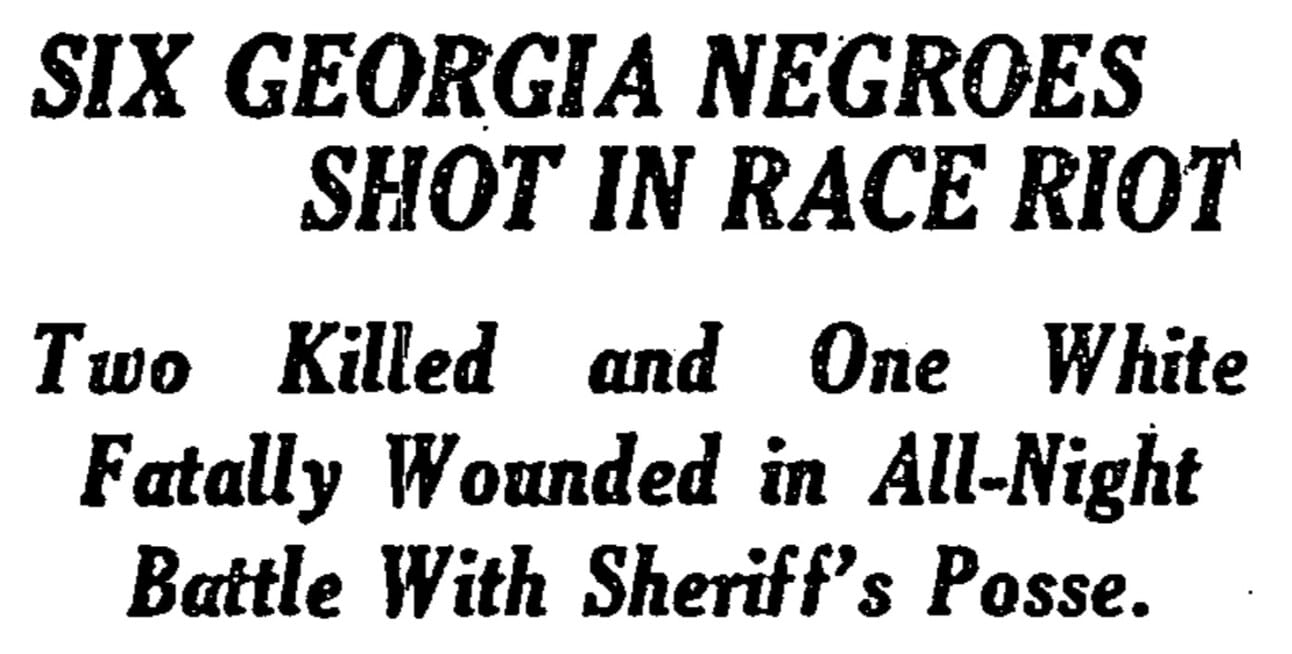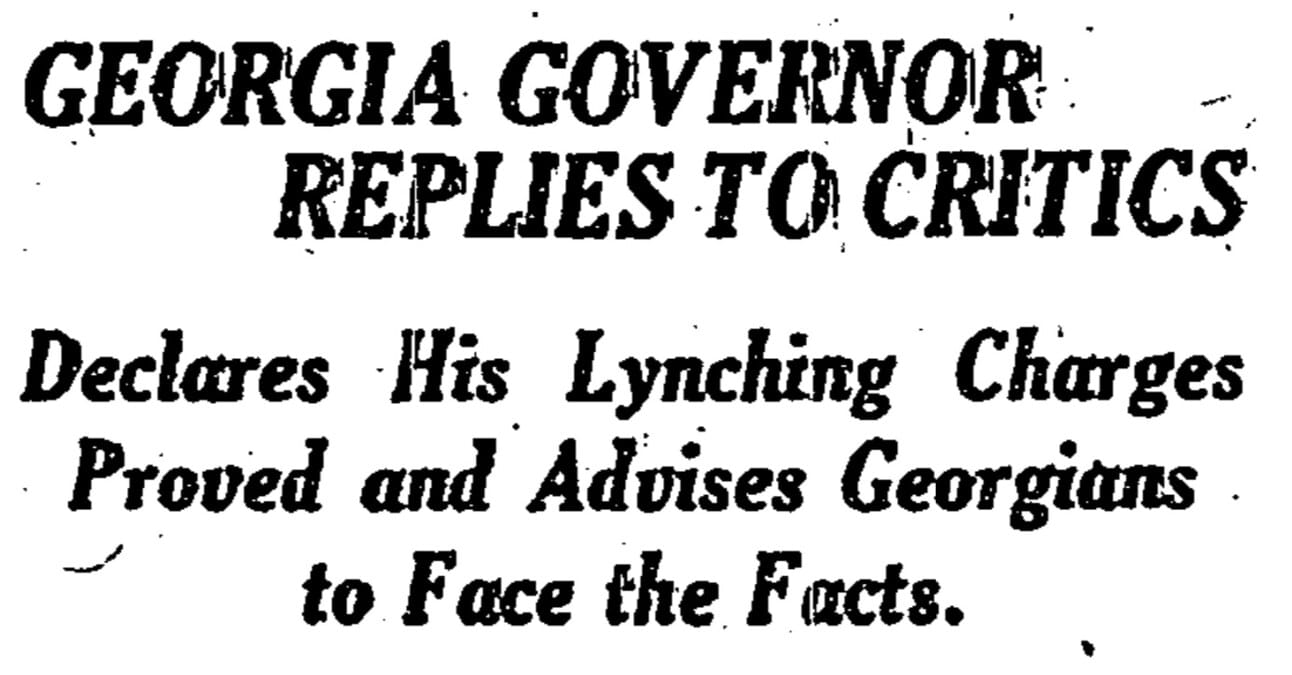- Strange Times
- Posts
- Strange Times 139: The Ex-Governor Is Now a Fugitive
Strange Times 139: The Ex-Governor Is Now a Fugitive
First of all, apologies for sending this email twice! Formatting errors in the first version caused several links and images to be omitted. I assure you that this will never happen again, unless it does.
Before we dive into today’s stories, I’d like to issue a content warning for hideous violence and racism—the sort the Jim Crow south specialized in. If that’s not what you’re looking for today, this may be an issue to skip.
Today we have three incredibly grim stories of racial violence in Florida and Georgia. Confront the bitter truths of history on…
May 19, 1921
Jailed for bigamy and accused of marrying eleven women, 20-year-old sailor Harold Hammond’s only defense, according to his lawyer, is that “he was having a lot of fun.”
Florenz Ziegfeld Jr. relocates his annual Midnight Frolic from New York to London, stating that as long as Prohibition reigns in the United States, “liberty is dead.”
A New York lady volunteers Susie, a pet orangutan with “engaging manners,” to assist at a fundraiser supporting watering stations for thirsty horses.
At the largest gathering of women college students in history, the President of Bryn Mawr declares that “We women can and must stop war!”
The Weather: Fair today and Friday; gentle variable winds.

If you were hoping for an adorable story about political cats, well, you will be disappointed. This is far from the first appearance of peonage charges in this newsletter, but it is certainly the first ex-governor charged. I will not spoil the conclusion of Catts’ indictment, but I will say that eight years later he was charged with financing a counterfeiting ring that planned to put $1,000,000 in fake money into circulation.
PENSACOLA, Fla., May 18.—Ex-Governor Sidney J. Catts was indicted at 4 o’clock this afternoon in the United States Court on two charges of peonage, and will be arrested when he can be found.
He is charged with having held two negroes, named Edward Brown and John Henry Rogers, in servitude on his plantation in Walton County. It is alleged that Catts, exercising the power of pardon, released the negroes from the State prison camp and had them taken to his farm.
The indictments are understood to have been voted solidly by the Federal Jury, and followed an examination of witnesses, including the two negroes.
The whereabouts of Catts is not known, but it was reported in the Federal court room that he was in North Carolina. He could not be found in Walton County, where he has been making his home since he left the State capital in January.
The ex-Governor is now a fugitive from justice from both the Federal and the State courts, having been recently indicted in connection with with the alleged acceptance of a bribe in regard to the pardoning of negroes and white men.
Should Catts be arrested he will be tried in Pensacola. The charges against him will be heard separately.

We are all enlightened enough, I hope, to be suspicious of the phrase “race riot,” as well as the testimony of the posse. I have no way of knowing what really happened in Byromville, but I am certain this is not even half the story.
BYROMVILLE, Ga., May 18—Two negroes are dead, one white man is at point of death and four negroes are wounded, one seriously, as a result of a race riot that began here late last night and extended into today. The trouble began over an attempt of Chief of Police Cunningham to collect city taxes from Fate Chapman, a negro on Will Byrom’s farm. The negro is said to have refused to settle.
All of the negroes in this section were summoned to Chapman’s house, where they defied the authorities.
It was nearly midnight last night when Sheriff Vinson, Deputy Sheriff Carl Lewis and others in a posse, including L.C. Davis, a former soldier, whose home is in Somerville, N.J., moved on the negroes’ quarters. They found more than twenty barricaded in Chapman’s house.
As the white men approached, the negroes are alleged to have opened fire. Davis fell wounded, receiving eight wounds, the worst being in the thigh.
The negroes held the house until the posse of officers, which had been increased in size, threatened to burn the structure. They then ran out, but there was more shooting and one negro was killed and four negroes were wounded.
A son of Fate Chapman got away from the posse and was traced to Lilly, where he again put up a fight this morning and was shot dead.
Sheriff Vinson and his deputies captured twenty blacks and seized twenty-five firearms. The prisoners were carried to Vienna, the county seat of Dooly County, where one of them is said to have confessed to a plot to kill Chief of Police Cunningham over the attempt to collect taxes.
Byromville is quiet tonight, and, with the remaining negroes disarmed, no further trouble is expected.

This ran alongside the above story, and it serves as a useful reminder that, even in 1921, people knew the situation in the south was a nightmare. The Governor in question is Hugh Dorsey, who prosecuted Leo Frank, victim of one of the most famous lynchings of the era. Readers with JSTOR access can learn more about Dorsey’s report in this article. The case referred to by Senator Olive, in which a Black man was burned to death by a mob, was likely the murder of John Lee Eberhardt, whose story is told here and here. I could find no specific record of the drowning mentioned by Governor Dorsey, but that, of course, means nothing.
ATLANTA, Ga., May 18.—Governor Hugh Dorsey today made a formal answer to State Senator Samuel Olive, Judge W.E.H. Searcy and others who have criticized his booklet, “The Negro in Georgia,” upholding his pamphlet, declaring his charges proved, and asserting that it was better for Georgians to face conditions as they are and try to remedy them than to satisfy themselves with mere denials.
The Governor lays emphasis on the fact that he withheld names and counties in order not to bring embarrassment upon any section of the State, and claims that Judge Searcy and Senator are responsible for the criticism that might be launched at their own counties, which they mentioned.
He asserts that the case which Senator Olive mentioned, in which a negro was burned to death, was not referred to at all in his pamphlet, and merely adds another to the long list of lynchings, and he asserts that since the booklet was issued a negro woman has been drowned by a mob.
As to Judge Searcy of the Flint Judicial Circuit, who was most severe in his criticism, Governor Dorsey’s comment is that the Judge has lost his “judicial calm” and that the heated tone of his communications strengthens the Governor’s conclusions as to the cases in Judge Searcy’s circuit and verifies his judgment as to the wisdom of withholding the names of his informants.
There was not a case cited in the pamphlet, says the Governor, which was not supported by a signed letter or report, and this evidence is open to the inspection of judges, solicitors, members of the Legislature, editors, preachers and other leaders of opinion to whom he appealed. He declares unequivocally that issuance of the pamphlet was wise, because outside papers are praising Georgia instead of criticizing. He closes with the statement that he is confident of a final verdict by the people in support of what he has done.
“While I mentioned only five cases,” said Governor Dorsey, “since 1885 mobs in Georgia have shot, hanged, burned or drowned 415 negroes, some of them women. Since these figures were compiled, in the last sixty days, a mob has taken a helpless old negro woman from her home and drowned her by night.”


